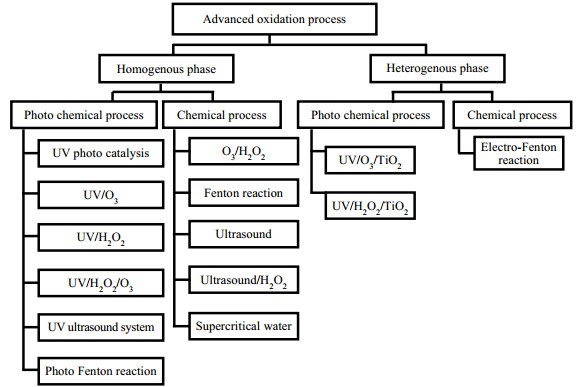2. 浙江大学 化学工程与生物工程学院, 浙江 杭州 310027
2. College of Chemical and Biological Engineering, Zhejiang University, Hangzhou 310027, China
内分泌干扰物(endocrine disrupting compounds,EDCs)被定义为能干扰和影响生物体自身荷尔蒙合成、分泌、传递、结合、活性反应、代谢和消解等的外源性化学物质,主要包括药物和个人护理用品、邻苯二甲酸盐、多氯联苯、多环芳烃、烷基酚、烷基酚聚氧乙烯醚、杀虫剂和增塑剂等[1-2]。极低的内分泌干扰物暴露浓度便能对生物体的生理机能造成严重危害,导致鱼类、鸟类、爬行类及哺乳类动物出现生殖器官变异、内分泌失常、种群退化等问题[3-5],且对人体发育、生育、神经产生严重影响,诱发糖尿病、心血管病、肥胖、癌症、甲状腺问题以及神经系统疾病等[6-7]。传统的工业废水和生活污水处理技术,如沉积、絮凝、膜分离、吸附等并不能有效地将其去除,残留物将随处理水排入自然水体中,并成为水环境中内分泌干扰物的主要来源[12-13]。近年来,研究者们致力于将各种生物、物理和化学处理技术应用于EDCs的去除,如图 1所示。然而,较大的处理能耗、较低的处理效率以及较高的运行与维护成本制约了此类技术的实际应用。为了克服上述处理技术中的不足,实现EDCs的高效广谱去除,研究者们尝试整合生物、物理和化学处理技术,通过多技术的组合联用提高EDCs的广谱去除效率[14-18]。
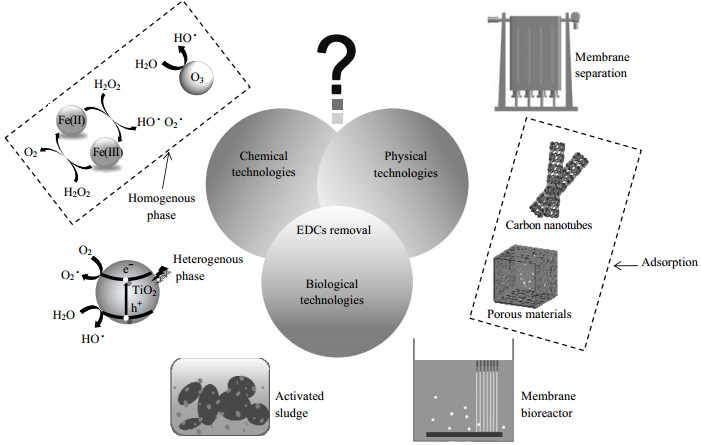
|
图 1 水体EDCs的脱除技术 Fig.1 Technologies for EDCs removal in water |
已报道的文章倾向于针对性地利用单一处理技术去除EDCs,而本综述则针对多技术的组合联用,系统地介绍不同技术联用过程的特点,对比分析多技术组合对不同种类EDCs的去除效率,总结并提出纳米技术与绿色可持续技术具有去除水体中EDCs的应用潜力。
2 内分泌干扰物的去除技术 2.1 物理处理技术内分泌干扰物的物理处理技术主要包括吸附和膜分离。吸附技术利用吸附材料的高比表面积、高孔隙率及吸附材料与内分泌干扰物间的相互作用等特性实现EDCs的去除。活性炭被认为是最有效且最经济的EDCs吸附去除材料,其去除效果与活性炭的亲疏水性、表面电荷、粒子尺寸及EDCs的辛醇-水分配系数有关[19-20]。生物质炭作为低成本的环保型吸附剂,有望取代活性炭应用于EDCs的去除过程中[21]。生物质炭经过蒸汽活化、化学改性、浸渍或热处理等方法修饰后,其表面吸附活性基团如羟基、羧基、羰基等含量增加,极大提高了其对水中EDCs的吸附效率[22-23]。
膜分离技术是另一类典型的物理处理技术。膜材料的孔径、表面亲疏水性及表面荷电性不同,其对污染物的处理效果也不尽相同[24-25],膜材料的理化性质、EDCs的理化性质与膜对EDCs的截留效率三者间的对应关系如图 2所示,图中,Mr为相对分子质量,Mr, co为截留相对分子质量,KOW为辛醇-水分配系数,pKa为解离常数,dm为膜孔径,RO为反渗透膜分离技术,FO为正渗透膜分离技术,NF为纳滤膜分离技术,UF为超滤膜分离技术。由于膜孔径过大,微滤无法有效截留EDCs[26]。超滤技术则根据目标污染物EDCs和膜材料的不同,对EDCs的去除效率具有较大差别,某些激素衍生物(如双氯芬酸、雌酮、雌二醇)可通过超滤过程去除[27],而极性较弱的邻苯二甲酸酯类则无法通过超滤截留去除[28]。纳滤分离技术由于其较小的分离孔径、较低的驱动压力,在EDCs去除中得到了广泛应用。与超滤技术相似,纳滤分离技术对EDCs的分离效率与膜材料和运行条件息息相关[29-32]。反渗透过程对绝大部分EDCs具有良好的去除效率,但高昂的运行费用限制了其在该领域的应用[33-35]。
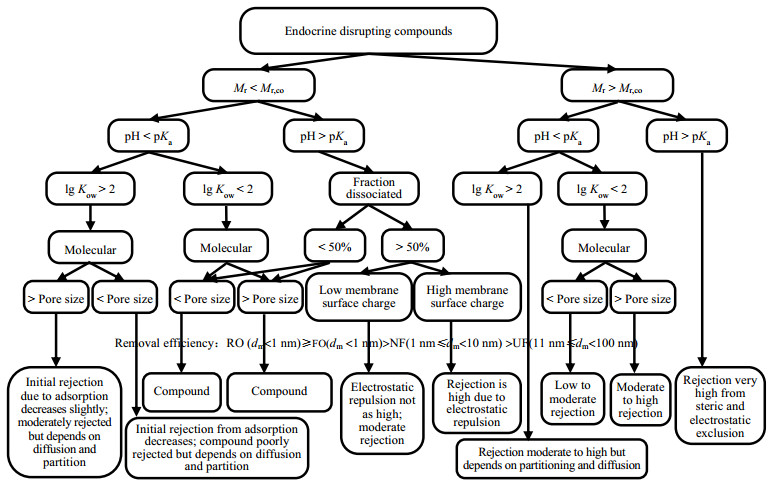
|
图 2 膜材料的理化性质、EDCs的理化性质与膜对EDCs的截留效率三者间的对应关系[36] Fig.2 Retention diagram for EDCs during membranes treatment based on EDCs and membrane properties. Modified from reference[36] |
虽然包括吸附和膜分离技术在内的物理处理技术在EDCs的去除中表现出较大的应用潜力,但经过物理处理技术产生的高浓度污染物仍需进一步处置和降解。
2.2 化学处理技术化学处理技术通过一系列氧化反应,将污染物转化为对环境危害低、易生物降解的物质或直接降解为二氧化碳与水等。化学处理技术分为传统氧化技术与高级氧化技术。传统氧化技术包括氯化、臭氧氧化和光分解等[37],但反应副产物的产生、污染物去除效率低等问题限制了其应用。高级氧化技术具有强氧化性,可降解大多数EDCs。高级氧化技术的分类如图 3所示,主要包括芬顿法[39-41]、光催化氧化[37]、电芬顿法[42]、臭氧催化氧化[43]、超声氧化等。但高级氧化技术仍存在运营费用高昂、能耗高、产生毒性氧化副产物等问题。将其与生物或物理处理技术联用可为大部分EDCs的去除提供新思路。
2.3 生物处理技术生物处理技术基于生物对EDCs的降解,是目前应用最广泛的EDCs去除方法。微生物(如细菌、真菌、藻类等)可将高相对分子质量污染物降解成小分子,甚至完全降解成二氧化碳与水等[44]。污染物的理化性质、可生化性与处理过程的运行参数等因素制约了生物处理效能与稳定性。传统的生物处理技术包括活性污泥法[45]、生物滤地法[46]、移动床膜生物反应器[47-48]等,非传统的生物处理技术包括生物吸附法[49]、膜生物反应器[50]和人工湿地[51-53]等。传统与非传统的生物处理技术均具有运行成本低的特点,皆可应用于水体中多种EDCs的去除。但生物处理技术的处理周期较长,且大多数生物技术仅针对特定EDCs的去除。因此,将生物处理技术与其他处理技术如膜分离技术、高级氧化技术组合,有望获得更好的EDCs去除效果。
3 多技术组合联用对水中内分泌干扰物的去除单一的水处理技术对水体中大部分EDCs的去除效果并不理想,近年来研究者们尝试采用多技术组合联用的方法,提升水体中EDCs的去除效果。通过将EDCs处理单元技术联用,可实现各单元处理技术间的优势互补,有效减少废水处理过程中残留EDCs对水环境的影响。
3.1 生物处理技术与物理处理技术的组合联用生物处理技术应用最为广泛,大多数组合联用工艺首先采用生物处理技术对含EDCs水体进行处理,随后组合物理处理技术实现强化水体中EDCs去除效果的目的。
将膜生物反应器(MBR)与纳滤或反渗透(NF/RO)等膜分离技术组合并应用于水体中EDCs的去除是近几年的研究热点之一[54-55]。有研究表明,膜生物反应器对亲水和易生物降解的EDCs具有较好的去除效果,而对于疏水和具有生物持久性的EDCs的去除效果不佳[50, 54, 56-57]。而基于孔径筛分或者静电排斥作用等膜分离机理,疏水性EDCs可通过反渗透或纳滤分离过程有效去除[58-59]。因此,经过膜生物反应器处理后残留的疏水以及部分亲水EDCs,可通过后续的膜分离过程有效去除。将膜生物反应器技术与纳滤或反渗透膜分离技术(MBR-NF/RO)组合联用可提升水体中EDCs的整体去除效率。表 1总结了MBR-NF/RO组合联用对水体中部分EDCs的去除效果[54-55],表中E1为雌酮,E2为雌二醇,E3为雌三醇,EE2为乙炔基雌二醇。结果表明,通过MBR-NF/RO组合联用处理后,绝大部分EDCs完全降解或浓度降低至可检测浓度以下。MBR-RO组合联用可实现对绝大部分EDCs高于99% 的去除效率,而MBR-NF组合联用对大部分EDCs的去除效率也能达到95%。对于高浓度EDCs水体的处理,MBR-NF/RO组合联用法仍能实现对EDCs的有效去除。但对于MBR-NF组合联用法而言,其双酚A、五氯苯酚、对乙酰氨基酚、酰胺咪嗪、甲硝哒唑等的去除效率相对较低(< 90%)。此外,高能耗与膜污染也在一定程度上限制了MBR-NF/RO组合联用法的发展。
|
|
表 1 膜生物反应器与纳滤或反渗透膜分离技术组合联用对部分内分泌干扰物的去除效果 Table 1 Integration of membrane bioreactor and nanofiltration/reversed osmosis membrane filtration process for EDCs removal |
渗透膜生物反应器是近期废水处理领域的研究热点之一。该方法将生物处理技术、正渗透与反渗透膜分离技术有效结合,经生物处理-正渗透分离-反渗透分离处理可获得高质量的再生用水[60-61]。对比传统膜反应器,渗透膜反应器采用具有高分离性能的正渗透膜和反渗透膜,因而对EDCs具有广谱的高去除效率(> 99%),尤其是针对亲水与难生物降解的EDCs。
将UF、活性污泥技术(ASP)以及絮凝(F)技术组合联用是一种性价比较高的水体EDCs处理方法[28]。将ASP与F技术组合联用,阳离子絮凝剂可增强EDCs的可生物降解性,显著提高ASP过程对EDCs的降解效率。污泥与超滤膜均对邻苯二甲酸酯类以及某些酚类物质具有吸附作用,ASP对酸性药物具有良好的降解效果,而UF则对酚类物质的去除更加有效。因此,以好氧生物降解为主要污染物去除机制的F+ASP+UF组合联用法,对包括水杨酸、对叔丁基苯酚、异丁苯丙酸和甲氧萘丙酸等在内的大部分EDCs都具有良好的降解去除作用。虽然,对于少数EDCs(如DEHP、2, 4-D和酰胺咪嗪等)的去除效率有限,但F+ASP+UF组合联用法对EDCs的整体去除效果优于其中任一单一处理技术及ASP+F的组合联用。
3.2 化学处理技术与其他处理技术的组合联用高级氧化技术在各种EDCs的处理过程中均表现出良好的去除效果。因此,常将臭氧氧化、超声、伽马射线等处理技术与其他物理或生物处理技术组合联用,强化水体中EDCs的去除效率[62]。表 2总结了几种高级氧化技术与其他处理技术的组合联用及其对EDCs的去除效果[54, 63-64]。
|
|
表 2 高级氧化技术与其他处理技术的组合联用及其对内分泌干扰物的去除效果 Table 2 Integration of advanced oxidation processes and other treatment processes for EDCs removal |
Nguyen将膜生物反应器与紫外(UV)氧化技术组合联用,通过MBR技术处理去除易生物降解及亲水性物质,通过紫外氧化技术显著降低难生物降解的疏水性物质含量,从而有效提高水体EDCs的去除效率[54]。MBR+UV组合联用可完全去除或将E1、甲氧萘丙酸和异丁苯丙酸等的浓度降至可检测范围以下。对于难生物降解的酰胺咪嗪,通过单一的MBR技术或紫外氧化技术,其去除率分别只能达到约32% 和30%,而通过MBR+UV技术联用则可实现90% 以上的酰胺咪嗪的去除。
电化学技术与MBR技术组合联用(eMBR)也被应用于水体中EDCs的去除,可在提高EDCs去除效率的同时,有效减少膜污染的产生[63, 65]。不同的电化学过程,如电氧化、电泳、电凝与MBR技术组合联用,结合电凝作用与膜分离技术,可有效去除废水中的阿莫西林(去除率72%)、酰胺咪嗪(去除率73%)和双氯芬酸(去除率75%)等EDCs。
将臭氧催化氧化、活性炭吸附和膜分离技术的组合联用,在水体EDCs的去除过程中也取得了良好的效果,如图 4所示[66-68]。臭氧的氧化过程有利于废水中强氧化性自由基的生成,促进EDCs的降解。负载有金属氧化物的活性炭,可进一步促进臭氧氧化过程中自由基的生成,大幅提高臭氧的催化氧化效率。活性炭在负载金属氧化物的同时,可将EDCs吸附并保留在活性炭的活性位点上,加速污染物的降解。最后通过膜分离过程,有效提升难降解与难吸附污染物、氧化反应副产物等的去除率。通过臭氧催化氧化、活性炭吸附和膜分离技术的组合联用可实现对水体中邻苯二甲酸、双氯芬酸的完全去除,并有效控制氧化反应副产物的产生。
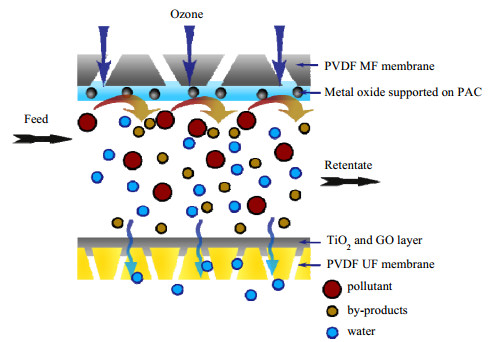
|
图 4 臭氧催化氧化、活性炭吸附和膜分离技术的组合联用工艺 Fig.4 Scheme of a hybrid system with ozonation, adsorption and membrane filtration processes |
超滤膜分离技术与粉末状活性炭(UF-PAC)或活性生物质炭(UF-ABC)的膜分离技术与吸附技术组合联用也具有去除水体中EDCs的应用潜力[69]。超滤膜分离技术与活性生物质炭吸附技术可通过半连续式反应器与吸附超滤膜2种方式进行组合联用,如图 5所示。相比于粉末状活性炭,由废弃生物质燃烧而成的活性生物质炭的比表面积较小,并以疏水吸附为其主要吸附机理。因此,UF+PAC组合联用具有更好的EDCs截留效果,而UF+ABC组合联用则具有更高的处理效率。将UF+ABC组合应用于水体EDCs的去除,在实现EDCs去除的同时,可减少废弃生物质的污染,被认为是UF+PAC组合联用的替代。
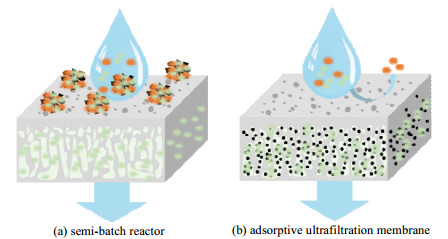
|
图 5 超滤膜分离技术与活性生物质炭吸附技术的组合联用
Fig.5 The scheme of hybrid systems with ultrafiltration membrane and activated biochar

|
相关研究也将超滤膜分离技术与以单壁碳纳米管为吸附材料的吸附技术组合联用(UF+SWNTs),实现对某些EDCs的去除[70]。UF+SWNTs组合联用依靠EDCs的疏水性实现污染物的截留与去除,但同时废水中有机物质间的疏水相互作用会加速膜材料的堵塞和污染。基于SWNTs的吸附作用及超滤膜的截留作用,该技术组合可有效提升17-β-雌二酮与双酚A的去除效率,且对疏水性更强的17-β-雌二酮的去除效果更好。
除上述多技术组合联用外,许多新材料与新处理技术也被应用于水体中EDCs组合联用去除过程,包括以纳米吸附剂[71-73]、金属氧化物[74-75]、负载氧化物的活性炭[76]、磁性粒子交换材料[77]等为基础的吸附技术和高级氧化技术,以金属有机骨架、固定化酶等改性的膜材料为基础的膜分离技术[78],以微藻处理过程为基础的生物处理技术等。此类新兴处理技术目前均处于实验研究阶段,距离实际应用仍有一定距离。
4 结语综述了生物、物理和化学处理技术在水体内分泌干扰物处理中的应用。现有单一处理技术在实际应用过程中受诸多因素限制,存在生物处理时间长、物理与生物处理产生的含污染物污泥的最终处理以及化学处理运营费用较高等不足。进一步总结了不同处理技术组合联用在水体内分泌干扰物去除中的应用,发现大多数组合联用工艺首先采用生物技术处理含EDCs水体,随后通过物理或化学处理技术实现强化水体中EDCs去除效果的目的。基于活性污泥法的多技术组合联用成本较低,基于膜生物反应器法的多技术组合联用可实现对多种EDCs的高效去除,而基于高级氧化的多技术组合联用,对大多数EDCs具有较高脱除效率。因此,依据实际处理需求将单一处理技术组合联用,为废水的高效处理提供了更多选择。
将单一处理技术组合联用可实现水中内分泌干扰物的广谱去除,但仍存在对部分EDCs无法完全去除的问题。针对上述难点,处理技术的组合联用需进一步研究与优化:(1)在组合联用工艺中引入新兴处理材料与处理技术,例如纳米材料或以纳米材料为基础的处理技术;(2)深入研究组合联用过程中EDCs去除的反应动力学与EDCs降解机理,针对性地设计反应器,优化运行工艺等;(3)合理组合处理技术,优化联用工艺,利用可再生资源降低处理成本,实现组合联用工艺的绿色化与低碳化;(4)通过中试放大或工程示范,评估多技术组合联用处理的实际效能。
| [1] |
WEE S Y, ARIS A Z, YUSOFF F M, et al. Occurrence of multiclass endocrine disrupting compounds in a drinking water supply system and associated risks[J]. Scientific Reports, 2020, 10(1): 17755. DOI:10.1038/s41598-020-74061-5 |
| [2] |
LI J, PANG S Y, WANG Z, et al. Oxidative transformation of emerging organic contaminants by aqueous permanganate: kinetics, products, toxicity changes, and effects of manganese products[J]. Water Research, 2021, 203: 117513. DOI:10.1016/j.watres.2021.117513 |
| [3] |
LUO Y L, GUO W S, NGO H H, et al. A review on the occurrence of micropollutants in the aquatic environment and their fate and removal during wastewater treatment[J]. Science of the Total Environment, 2014, 473/474: 619-641. DOI:10.1016/j.scitotenv.2013.12.065 |
| [4] |
ESPLUGAS S, BILA D M, KRAUSE L G, et al. Ozonation and advanced oxidation technologies to remove endocrine disrupting chemicals (EDCs) and pharmaceuticals and personal care products (PPCPs) in water effluents[J]. Journal of Hazardous Materials, 2007, 149(3): 631-642. DOI:10.1016/j.jhazmat.2007.07.073 |
| [5] |
BOLONG N, ISMAIL A F, SALIM M R, et al. A review of the effects of emerging contaminants in wastewater and options for their removal[J]. Desalination, 2009, 239(1/2/3): 229-246. |
| [6] |
RIBEIRO E, LADEIRA C, VIEGAS S. EDCs mixtures: A stealthy hazard for human health?[J]. Toxics, 2017, 5(1): 5-22. DOI:10.3390/toxics5010005 |
| [7] |
GRAY L E, JR. Twenty-five years after "Wingspread"- Environmental endocrine disruptors (EDCs) and human health[J]. Current Opinion in Toxicology, 2017, 3: 40-47. DOI:10.1016/j.cotox.2017.04.004 |
| [8] |
BELHAJ D, BACCAR R, JAABIRI I, et al. Fate of selected estrogenic hormones in an urban sewage treatment plant in Tunisia (North Africa)[J]. Science of the Total Environment, 2015, 505: 154-160. DOI:10.1016/j.scitotenv.2014.10.018 |
| [9] |
QIANG Z, DONG H, ZHU B, et al. A comparison of various rural wastewater treatment processes for the removal of endocrine-disrupting chemicals (EDCs)[J]. Chemosphere, 2013, 92(8): 986-992. DOI:10.1016/j.chemosphere.2013.03.019 |
| [10] |
LI R, KADRISPAHIC H, KOUSTRUP J M, et al. Removal of micropollutants in a ceramic membrane bioreactor for the post-treatment of municipal wastewater[J]. Chemical Engineering Journal, 2022, 427: 131458. DOI:10.1016/j.cej.2021.131458 |
| [11] |
史雨薇, 蔡灵, 潘辰苑, 等. 海洋环境中新型雌激素污染特征研究进展[J]. 高校化学工程学报, 2019, 33(6): 1285-1302. SHI Y W, CAI L, PAN C Y, et al. Research progress on emerging estrogenic pollutants in marine environment[J]. Journal of Chemical Engineering of Chinese Universities, 2019, 33(6): 1285-1302. |
| [12] |
KLAMERTH N, MALATO S, AGUERA A, et al. Photo-Fenton and modified photo-Fenton at neutral pH for the treatment of emerging contaminants in wastewater treatment plant effluents: A comparison[J]. Water Research, 2013, 47(2): 833-840. DOI:10.1016/j.watres.2012.11.008 |
| [13] |
AHMED M B, ZHOU J L, NGO H H, et al. Adsorptive removal of antibiotics from water and wastewater: Progress and challenges[J]. Science of the Total Environment, 2015, 532: 112-126. DOI:10.1016/j.scitotenv.2015.05.130 |
| [14] |
ZHANG Y, ZHAO P, LI J, et al. A hybrid process combining homogeneous catalytic ozonation and membrane distillation for wastewater treatment[J]. Chemosphere, 2016, 160: 134-140. DOI:10.1016/j.chemosphere.2016.06.070 |
| [15] |
WANG Y, WANG X, LI M, et al. Removal of pharmaceutical and personal care products (PPCPs) from municipal waste water with integrated membrane systems, MBR-RO/NF[J]. International Journal of Environmental Research and Public Health, 2018, 15(2): 269-281. DOI:10.3390/ijerph15020269 |
| [16] |
RACAR M, DOLAR D, KARADAKIC K, et al. Challenges of municipal wastewater reclamation for irrigation by MBR and NF/RO: Physico-chemical and microbiological parameters, and emerging contaminants[J]. Science of the Total Environment, 2020, 722: 137959. DOI:10.1016/j.scitotenv.2020.137959 |
| [17] |
DHANGAR K, KUMAR M. Tricks and tracks in removal of emerging contaminants from the wastewater through hybrid treatment systems: A review[J]. Science of the Total Environment, 2020, 738: 140320. DOI:10.1016/j.scitotenv.2020.140320 |
| [18] |
NADDEO V, SECONDES M F N, BOREA L, et al. Removal of contaminants of emerging concern from real wastewater by an innovative hybrid membrane process-ultrasound, adsorption, and membrane ultrafiltration (USAMe(R))[J]. Ultrason Sonochemistry, 2020, 68: 105237. DOI:10.1016/j.ultsonch.2020.105237 |
| [19] |
SOTELO J L, RODRIGUEZ A R, MATEOS M M, et al. Adsorption of pharmaceutical compounds and an endocrine disruptor from aqueous solutions by carbon materials[J]. Journal of Environmental Science and Health Part B-Pesticides Food Contaminants and Agricultural Wastes, 2012, 47(7): 640-652. |
| [20] |
NAM S W, CHOI D J, KIM S K, et al. Adsorption characteristics of selected hydrophilic and hydrophobic micropollutants in water using activated carbon[J]. Journal of Hazardous Materials, 2014, 270: 144-152. DOI:10.1016/j.jhazmat.2014.01.037 |
| [21] |
JUNG C, BOATENG L K, FLORA J R V, et al. Competitive adsorption of selected non-steroidal anti-inflammatory drugs on activated biochars: experimental and molecular modeling study[J]. Chemical Engineering Journal, 2015, 264: 1-9. DOI:10.1016/j.cej.2014.11.076 |
| [22] |
AHMED M B, ZHOU J L, NGO H H, et al. Progress in the preparation and application of modified biochar for improved contaminant removal from water and wastewater[J]. Bioresource Technology, 2016, 214: 836-851. DOI:10.1016/j.biortech.2016.05.057 |
| [23] |
WANG J, ZHANG M. Adsorption characteristics and mechanism of bisphenol A by magnetic biochar[J]. International Journal of Environmental Research and Public Health, 2020, 17(3): 1075-1092. DOI:10.3390/ijerph17031075 |
| [24] |
SCHAFER A I, AKANYETI I, SEMIAO A J. Micropollutant sorption to membrane polymers: A review of mechanisms for estrogens[J]. Advances in Colloid and Interface Science, 2011, 164(1/2): 100-117. |
| [25] |
SIMMONS F J, KUO D H, XAGORARAKI I. Removal of human enteric viruses by a full-scale membrane bioreactor during municipal wastewater processing[J]. Water Research, 2011, 45(9): 2739-2750. DOI:10.1016/j.watres.2011.02.001 |
| [26] |
KATIBI K K, YUNOS K F, CHE MAN H, et al. Recent advances in the rejection of endocrine-disrupting compounds from water using membrane and membrane bioreactor technologies: A review[J]. Polymers, 2021, 13(3): 392-443. DOI:10.3390/polym13030392 |
| [27] |
BABAEI A A, LIMA E C, TAKDASTAN A, et al. Removal of tetracycline antibiotic from contaminated water media by multi-walled carbon nanotubes: Operational variables, kinetics, and equilibrium studies[J]. Water Science and Technology, 2016, 74(5): 1202-1216. DOI:10.2166/wst.2016.301 |
| [28] |
MELO-GUIMARAES A, TORNER-MORALES F J, DURAN-ALVAREZ J C, et al. Removal and fate of emerging contaminants combining biological, flocculation and membrane treatments[J]. Water Science and Technology, 2013, 67(4): 877-885. DOI:10.2166/wst.2012.640 |
| [29] |
GUO H, PENG L E, YAO Z K, et al. Non-polyamide based nanofiltration membranes using green metal-organic coordination complexes: Implications for the removal of trace organic contaminants[J]. Environmental Science & Technology, 2019, 53(5): 2688-2694. |
| [30] |
GUO H, YAO Z K, YANG Z, et al. A one-step rapid assembly of thin film coating using green coordination complexes for enhanced removal of trace organic contaminants by membranes[J]. Environmental Science & Technology, 2017, 51(21): 12638-12643. |
| [31] |
GUO H, DENG Y, YAO Z K, et al. A highly selective surface coating for enhanced membrane rejection of endocrine disrupting compounds: Mechanistic insights and implications[J]. Water Research, 2017, 121: 197-203. DOI:10.1016/j.watres.2017.05.037 |
| [32] |
GUO H, DENG Y, TAO Z J, et al. Does hydrophilic polydopamine coating enhance membrane rejection of hydrophobic endocrine-disrupting compounds?[J]. Environmental Science & Technology Letters, 2016, 3(9): 332-338. |
| [33] |
DAI R, GUO H, TANG C Y, et al. Hydrophilic selective nanochannels created by metal organic frameworks in nanofiltration membranes enhance rejection of hydrophobic endocrine-disrupting compounds[J]. Environmental Science & Technology, 2019, 53(23): 13776-13783. |
| [34] |
SADMANI A H, ANDREWS R C, BAGLEY D M. Influence of naturally occurring dissolved organic matter, colloids, and cations on nanofiltration of pharmaceutically active and endocrine disrupting compounds[J]. Chemosphere, 2014, 117: 170-177. DOI:10.1016/j.chemosphere.2014.06.027 |
| [35] |
罗方, 闫康康, 王晶, 等. 基于改性纳米纤维支撑层的复合正渗透膜[J]. 高校化学工程学报, 2020, 34(5): 1151-1158. LUO F, YAN K K, WANG J, et al. Forward osmosis membranes based on modified nanofiber substrates[J]. Journal of Chemical Engineering of Chinese Universities, 2020, 34(5): 1151-1158. DOI:10.3969/j.issn.1003-9015.2020.05.008 |
| [36] |
KIM S, CHU K H, AL-HAMADANI Y A J, et al. Removal of contaminants of emerging concern by membranes in water and wastewater: A review[J]. Chemical Engineering Journal, 2018, 335: 896-914. DOI:10.1016/j.cej.2017.11.044 |
| [37] |
NOUTSOPOULOS C, MAMAIS D, MPOURAS T, et al. The role of activated carbon and disinfection on the removal of endocrine disrupting chemicals and non-steroidal anti-inflammatory drugs from wastewater[J]. Environmental Technology, 2014, 35(5/6/7/8): 698-708. |
| [38] |
JATOI A S, HASHMI Z, ADRIYANI R, et al. Recent trends and future challenges of pesticide removal techniques - A comprehensive review[J]. Journal of Environmental Chemical Engineering, 2021, 9(4): 105571. DOI:10.1016/j.jece.2021.105571 |
| [39] |
IFELEBUEGU A O, EZENWA C P. Removal of endocrine disrupting chemicals in wastewater treatment by Fenton-like oxidation[J]. Water Air and Soil Pollution, 2011, 217(1/2/3/4): 213-220. |
| [40] |
ZIEMBOWICZ S, KIDA M, KOSZELNIK P. Reservoir bottom sediments as heterogeneous catalysts for effective degradation of a selected endocrine-disrupting chemical via a Fenton-like process[J]. Journal of Water Process Engineering, 2019, 32: 100950. DOI:10.1016/j.jwpe.2019.100950 |
| [41] |
余涛, 张萌, 林秋健, 等. 猪场废水Fenton法深度除碳研究[J]. 高校化学工程学报, 2018, 32(2): 667-674. YU T, ZHANG M, LIN Q J, et al. Advanced removal of organics from swine wastewater by Fenton process[J]. Journal of Chemical Engineering of Chinese Unversities, 2018, 32(2): 667-674. |
| [42] |
ROSALES E, BUFTIA G, PAZOS M, et al. Highly active based iron-carbonaceous cathodes for heterogeneous electro-Fenton process: application to degradation of parabens[J]. Process Safety and Environmental Protection, 2018, 117: 363-371. DOI:10.1016/j.psep.2018.05.014 |
| [43] |
蔡应康, 刘茂春, 李卫星, 等. 臭氧催化氧化降解2, 4, 6-三氯苯酚研究[J]. 高校化学工程学报, 2018, 32(3): 725-730. CAI Y K, LIU M C, LI W X, et al. Study on catalytic ozonation of 2, 4, 6-trichlorophenol[J]. Journal of Chemical Engineering of Chinese Unveristies, 2018, 32(3): 725-730. DOI:10.3969/j.issn.1003-9015.2018.03.030 |
| [44] |
DE OLIVEIRA J F, FIA R, RODRIGUES F N, et al. Quantification, removal and potential ecological risk of emerging contaminants in different organic loads of swine wastewater treated by integrated biological reactors[J]. Chemosphere, 2020, 260: 127516. DOI:10.1016/j.chemosphere.2020.127516 |
| [45] |
LIU Z H, KANJO Y, MIZUTANI S. Removal mechanisms for endocrine disrupting compounds (EDCs) in wastewater treatment - physical means, biodegradation, and chemical advanced oxidation: A review[J]. Science of the Total Environment, 2009, 407(2): 731-748. DOI:10.1016/j.scitotenv.2008.08.039 |
| [46] |
SVENSON A, ALLARD A S, EK M. Removal of estrogenicity in Swedish municipal sewage treatment plants[J]. Water Research, 2003, 37(18): 4433-4443. DOI:10.1016/S0043-1354(03)00395-6 |
| [47] |
PHAN H V, HAI F I, KANG J, et al. Simultaneous nitrification/denitrification and trace organic contaminant (TrOC) removal by an anoxic-aerobic membrane bioreactor (MBR)[J]. Bioresource Technology, 2014, 165: 96-104. DOI:10.1016/j.biortech.2014.03.094 |
| [48] |
AHMED M B, ZHOU J L, NGO H H, et al. Progress in the biological and chemical treatment technologies for emerging contaminant removal from wastewater: A critical review[J]. Journal of Hazardous Materials, 2017, 323: 274-298. DOI:10.1016/j.jhazmat.2016.04.045 |
| [49] |
NGUYEN L N, HAI F I, YANG S F, et al. Removal of pharmaceuticals, steroid hormones, phytoestrogens, UV-filters, industrial chemicals and pesticides by Trametes versicolor: Role of biosorption and biodegradation[J]. International Biodeterioration & Biodegradation, 2014, 88: 169-175. |
| [50] |
CLARA M, STRENN B, GANS O, et al. Removal of selected pharmaceuticals, fragrances and endocrine disrupting compounds in a membrane bioreactor and conventional wastewater treatment plants[J]. Water Research, 2005, 39(19): 4797-4807. DOI:10.1016/j.watres.2005.09.015 |
| [51] |
GORITO A M, RIBEIRO A R, ALMEIDA C M R, et al. A review on the application of constructed wetlands for the removal of priority substances and contaminants of emerging concern listed in recently launched EU legislation[J]. Environmental Pollution, 2017, 227: 428-443. DOI:10.1016/j.envpol.2017.04.060 |
| [52] |
ILYAS H, MASIH I, VAN HULLEBUSCH E D. A decision tree framework to support design, operation, and performance assessment of constructed wetlands for the removal of emerging organic contaminants[J]. Science of the Total Environment, 2021, 760: 143334. DOI:10.1016/j.scitotenv.2020.143334 |
| [53] |
MATAMOROS V, CAIOLA N, ROSALES V, et al. The role of rice fields and constructed wetlands as a source and a sink of pesticides and contaminants of emerging concern: Full-scale evaluation[J]. Ecological Engineering, 2020, 156: 105971. DOI:10.1016/j.ecoleng.2020.105971 |
| [54] |
NGUYEN L N, HAI F I, KANG J G, et al. Removal of emerging trace organic contaminants by MBR-based hybrid treatment processes[J]. International Biodeterioration & Biodegradation, 2013, 85: 474-482. |
| [55] |
DOLAR D, GROS M, RODRIGUEZ-MOZAZ S, et al. Removal of emerging contaminants from municipal wastewater with an integrated membrane system, MBR-RO[J]. Journal of Hazardous Materials, 2012, 239/240: 64-69. DOI:10.1016/j.jhazmat.2012.03.029 |
| [56] |
ALTURKI A A, TADKAEW N, MCDONALD J A, et al. Combining MBR and NF/RO membrane filtration for the removal of trace organics in indirect potable water reuse applications[J]. Journal of Membrane Science, 2010, 365(1/2): 206-215. |
| [57] |
TADKAEW N, HAI F I, MCDONALD J A, et al. Removal of trace organics by MBR treatment: The role of molecular properties[J]. Water Research, 2011, 45(8): 2439-2451. DOI:10.1016/j.watres.2011.01.023 |
| [58] |
BELLONA C, DREWES J E, XU P, et al. Factors affecting the rejection of organic solutes during NF/RO treatment- a literature review[J]. Water Research, 2004, 38(12): 2795-2809. DOI:10.1016/j.watres.2004.03.034 |
| [59] |
NGHIEM L D, SCHAFER A I, ELIMELECH M. Pharmaceutical retention mechanisms by nanofiltration membranes[J]. Environmental Science & Technology, 2005, 39(19): 7698-7705. |
| [60] |
LUO W, PHAN H V, XIE M, et al. Osmotic versus conventional membrane bioreactors integrated with reverse osmosis for water reuse: Biological stability, membrane fouling, and contaminant removal[J]. Water Research, 2017, 109: 122-134. DOI:10.1016/j.watres.2016.11.036 |
| [61] |
LI Y, ZHANG B X, LI G X, et al. Osmotic membrane bioreactor and its hybrid systems for wastewater reuse and resource recovery: Advances, challenges, and future directions[J]. Current Pollution Reports, 2018, 4(1): 23-34. DOI:10.1007/s40726-018-0080-1 |
| [62] |
ROSMAN N, SALLEH W N W, MOHAMED M A, et al. Hybrid membrane filtration-advanced oxidation processes for removal of pharmaceutical residue[J]. Journal of Colloid and Interface Science, 2018, 532: 236-260. DOI:10.1016/j.jcis.2018.07.118 |
| [63] |
ENSANO B M B, BOREA L, NADDEO V, et al. Control of emerging contaminants by the combination of electrochemical processes and membrane bioreactors[J]. Environmental Science and Pollution Research, 2019, 26(2): 1103-1112. DOI:10.1007/s11356-017-9097-z |
| [64] |
IBANEZ M, GRACIA-LOR E, BIJLSMA L, et al. Removal of emerging contaminants in sewage water subjected to advanced oxidation with ozone[J]. Journal of Hazardous Materials, 2013, 260: 389-398. DOI:10.1016/j.jhazmat.2013.05.023 |
| [65] |
MAMEDA N, PARK H J, CHOO K H. Membrane electro-oxidizer: A new hybrid membrane system with electrochemical oxidation for enhanced organics and fouling control[J]. Water Research, 2017, 126: 40-49. DOI:10.1016/j.watres.2017.09.009 |
| [66] |
LI Y, YEUNG K L. Polymeric catalytic membrane for ozone treatment of DEET in water[J]. Catalysis Today, 2019, 331: 53-59. DOI:10.1016/j.cattod.2018.06.005 |
| [67] |
HO H L, CHAN W K, BLONDY A, et al. Experiment and modeling of advanced ozone membrane reactor for treatment of organic endocrine disrupting pollutants in water[J]. Catalysis Today, 2012, 193(1): 120-127. DOI:10.1016/j.cattod.2012.03.059 |
| [68] |
CHAN W K, JOUET J, HENG S, et al. Membrane contactor/separator for an advanced ozone membrane reactor for treatment of recalcitrant organic pollutants in water[J]. Journal of Solid State Chemistry, 2012, 189: 96-100. DOI:10.1016/j.jssc.2012.01.023 |
| [69] |
KIM S, PARK C M, JANG A, et al. Removal of selected pharmaceuticals in an ultrafiltration-activated biochar hybrid system[J]. Journal of Membrane Science, 2019, 570/571: 77-84. DOI:10.1016/j.memsci.2018.10.036 |
| [70] |
HEO J, FLORA J R V, HER N, et al. Removal of bisphenol A and 17 beta-estradiol in single walled carbon nanotubes-ultrafiltration (SWNTs-UF) membrane systems[J]. Separation and Purification Technology, 2012, 90: 39-52. DOI:10.1016/j.seppur.2012.02.007 |
| [71] |
ZHAO L, DENG J, SUN P, et al. Nanomaterials for treating emerging contaminants in water by adsorption and photocatalysis: systematic review and bibliometric analysis[J]. Science of the Total Environment, 2018, 627: 1253-1263. DOI:10.1016/j.scitotenv.2018.02.006 |
| [72] |
YU C, SONG T, LIU A P, et al. p-BNMR/TiO2 hybrid materials with exposing the {001} facet for enhanced photocatalytic application in treatment of antibiotic contaminants[J]. Colloids and Surfaces a-Physicochemical and Engineering Aspects, 2020, 584: 124052. |
| [73] |
GHAMKHARI A, MOHAMADI L, KAZEMZADEH S, et al. Synthesis and characterization of poly(styrene-block-acrylic acid) diblock copolymer modified magnetite nanocomposite for efficient removal of penicillin G[J]. Composites Part B-Engineering, 2020, 182: 107643. DOI:10.1016/j.compositesb.2019.107643 |
| [74] |
SACCO O, VAIANO V, MATARANGOLO M. ZnO supported on zeolite pellets as efficient catalytic system for the removal of caffeine by adsorption and photocatalysis[J]. Separation and Purification Technology, 2018, 193: 303-310. DOI:10.1016/j.seppur.2017.10.056 |
| [75] |
SARRO M, GULE N P, LAURENTI E, et al. ZnO-based materials and enzymes hybrid systems as highly efficient catalysts for recalcitrant pollutants abatement[J]. Chemical Engineering Journal, 2018, 334: 2530-2538. DOI:10.1016/j.cej.2017.11.146 |
| [76] |
GUO Z, KANG Y, HU Z, et al. Removal pathways of benzofluoranthene in a constructed wetland amended with metallic ions embedded carbon[J]. Bioresource Technology, 2020, 311: 123481. DOI:10.1016/j.biortech.2020.123481 |
| [77] |
LOPEZ-ORTIZ C M, SENTANA-GADEA I, VARO-GALVAN P J, et al. Effect of magnetic ion exchange (MIEX((R))) on removal of emerging organic contaminants[J]. Chemosphere, 2018, 208: 433-440. DOI:10.1016/j.chemosphere.2018.05.194 |
| [78] |
KIM S, MUNOZ-SENMACHE J C, JUN B M, et al. A metal organic framework-ultrafiltration hybrid system for removing selected pharmaceuticals and natural organic matter[J]. Chemical Engineering Journal, 2020, 382: 122920. DOI:10.1016/j.cej.2019.122920 |





